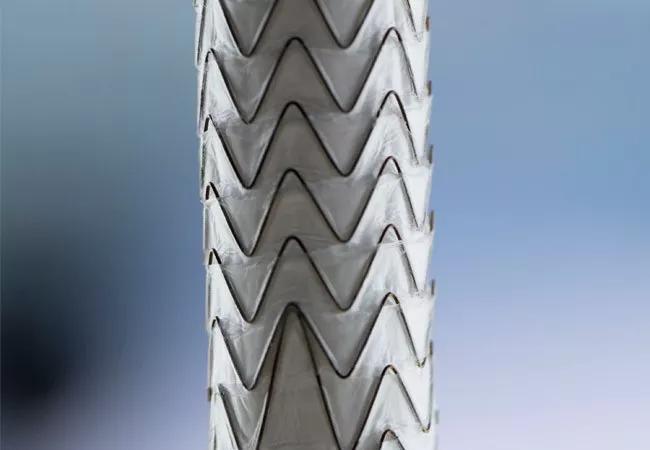Low rates of type IA endoleak in pooled data on Ovation platform

Endovascular abdominal aortic aneurysm repair (EVAR) with the Ovation Abdominal Stent Graft platform demonstrated 95.8% freedom from type IA endoleak and 94.0% freedom from type I or III endoleak at five years, according to pooled experience in nearly 1,300 patients. Aneurysm-related mortality at five years was 0.7%.
Advertisement
Cleveland Clinic is a non-profit academic medical center. Advertising on our site helps support our mission. We do not endorse non-Cleveland Clinic products or services. Policy
The results, published recently in the Journal of Vascular Surgery, were gleaned from the ENCORE database, which contains pooled results of use of the Ovation platform from five prospective clinical trials as well as prospective registry data.
“The Ovation experience demonstrates good durability and safety with EVAR both in clinical trials and in a real-world setting,” says Sean Lyden, MD, Chair of Vascular Surgery at Cleveland Clinic and a co-author of the study. “This analysis is useful not only for providing additional evidence of the safety of EVAR but as a basis for comparison with other devices and techniques.”
EVAR is now generally favored over open repair for treating abdominal aortic aneurysms in view of lower mortality and morbidity in the perioperative period and the first few postoperative years. However, graft-related problems related to device leakage may become an issue over time. The most common is loss of the proximal seal (type IA endoleak), potentially leading to reintervention, conversion to open repair or aneurysm rupture.
The Ovation platform (FDA-approved in 2012) uses a unique technique to achieve a proximal seal, with the aim of reducing the likelihood of type IA endoleak. After the stent is positioned, a polymer is deployed that sets in situ, achieving a graft that conforms to the anatomy of the aneurysm neck.
The newly published study was designed to evaluate the Ovation platform’s safety and durability.
The analysis retrospectively evaluated data from 1,296 patients who underwent EVAR with the Ovation platform from 2009 to 2017 — 795 from the ENCORE database and 501 from the prospectively maintained European Union Post-Market Registry. Mean age was 73 + 8 years, and 81% of patients were male. Half had complex aortic anatomy.
Advertisement
Perioperative outcomes. Results within the first 30 days included the following:
Three patients (0.2%) had a polymer leak intraoperatively, one of whom died on postoperative day 17. Aneurysm rupture occurred on day 28 secondary to a type IB endoleak; the patient underwent successful iliac extension. No conversions to open repair were done in the first 30 days.
Midterm outcomes. Median follow-up was 2.8 years, with 71% of patients followed through the first year and 23% through five years. Midterm outcomes included the following:
Over the study period, four aneurysm ruptures and eight conversions to open repair occurred.
Major takeaways from the study include the following points:
EVAR demonstrates good safety, even for patients with complex aortic anatomy. “The low rates of mortality and type I and III endoleaks are particularly important indicators that the procedure is safe and the device is durable,” says Dr. Lyden. At the same time, he advises systematic long-term surveillance after EVAR for prompt detection of any endoleaks. He notes that early detection is especially critical for type IA endoleaks, as they present particular technical challenges to address.
Advertisement
Polymer leak during device placement was rare but must be considered. Although the risk of polymer leak was low, operators must be aware of this potential complication, which caused intraoperative hypotension in all cases. Close communication with the anesthesiology team during Ovation placement is critical so that hypotension may be promptly detected and addressed.
More device comparisons and long-term data are needed.Although comparisons of EVAR and open repair are abundant, data comparing different devices are scarce. Moreover, long-term evaluation is critical. “With younger patients now increasingly undergoing EVAR, it is especially important to collect data on long-term durability on all devices,” Dr. Lyden urges.
Advertisement
Advertisement

Microvascular “supercharging” is a critical newer step to promote favorable outcomes

Why Cleveland Clinic is launching its cardioimmunology center

End-of-treatment VALOR-HCM analyses reassure on use in women, suggest disease-modifying potential

New Cleveland Clinic data challenge traditional size thresholds for surgical intervention

3 specialists share multidisciplinary perspectives on a widely impactful cardiovascular condition

Experience-based takes on valve-sparing root replacement from two expert surgeons

Two surgeons share insights on weighing considerations across the lifespan

Join us in Florida this winter for a long-standing CME favorite